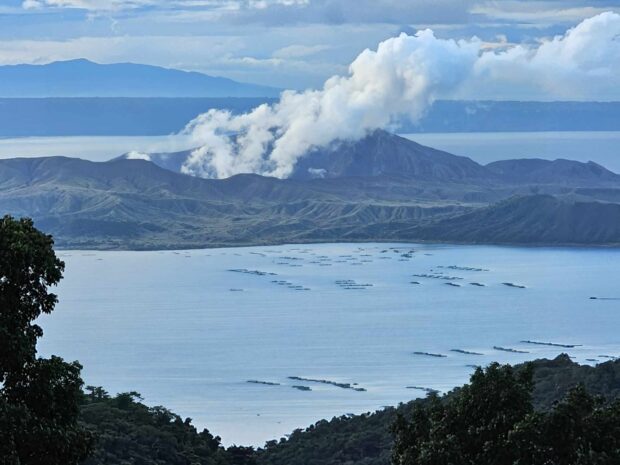Taal, Bulusan show signs of ‘increased activities’

BEAUTY IN A LAKE | The scenic view of Taal Volcano from Tagaytay City, Cavite, shown in this photo taken on Oct. 24, 2023, portrays calmness amid its continued emission of toxic gas. (Photo by MARLON MALLARI / Contributor)
MANILA, Philippines — The Philippine Institute of Volcanology and Seismology (Phivolcs) on Wednesday observed an increase in activities in Taal Volcano in Batangas province and Mount Bulusan in Sorsogon province.
In its 5 a.m. bulletin, Phivolcs said Taal again spewed a high volume of sulfur dioxide (SO2) on Tuesday.
The volcano emitted 11,434 metric tons (MT) of sulfur dioxide over the past 24 hours that rose to 1,500 meters above Taal Volcano Island, locally known as “Pulo,” before drifting southwest. The high level of emission was accompanied by a volcanic earthquake that lasted three minutes.
But to Shiela Tan, 70, a resident of Tagaytay City in Cavite province, the volcano looked calm on Wednesday morning.
“No frightening smoke was coming out of the volcano,” she said in a phone interview.
Article continues after this advertisementPhivolcs reported that the volcano started recording a high volume of toxic volcanic gas from Dec. 15 to Dec. 21 last year when it emitted 11,437 MT of SO2 daily.
Article continues after this advertisementOn Dec. 26, the level of emission dropped to 9,557 MT and further fell to 8,931 MT on Dec. 28 up to Tuesday. Taal’s SO2 emission reached 11,499 MT on Nov. 9, the highest last year.
“But if there will be vog again, we’re all back to the same safety measures — wearing face masks for the children and elders like me for protection,” Tan said.
The high level of SO2 emissions and sporadic steam releases have caused volcanic smog or “vog” — a harmful haze that contains volcanic ash and gas — to descend on areas close to the volcano.
Taal Volcano remained under alert level 1 (low level of volcanic unrest), which meant sudden steam-driven or phreatic explosions, volcanic earthquakes, minor ashfall, and lethal accumulations or expulsions of volcanic gas can occur and threaten areas within the Taal Volcano Island, Phivolcs said.
Earthquakes
In a Tuesday night advisory, Phivolcs said a total of 116 volcanic earthquakes were recorded on Mount Bulusan since 9 p.m. of Dec. 29.
Phivolcs said that 110 quakes were volcano-tectonic earthquakes associated with rock fracturing beneath the southern flanks at depths of 2 to 6 kilometers. The rest were low frequency volcanic earthquakes associated with movement of volcanic fluids.
“[The] increased seismic activity and pressurization of the volcano edifice may indicate that hydrothermal processes may be occurring beneath the volcano and may lead to steam-driven eruptions at any of the summit vents,” Phivolcs said in the advisory.
Alert level 1 was raised over Bulusan on Oct. 25 last year due to the increased volcanic activity.
The agency reminded the public to avoid entry into Bulusan’s 4-km radius permanent danger zone due to the increased chances of steam-driven eruptions.
People living within valleys and along river or stream channels were also advised to be vigilant against sediment-laden stream flows and lahar in the event of heavy and prolonged rainfall.